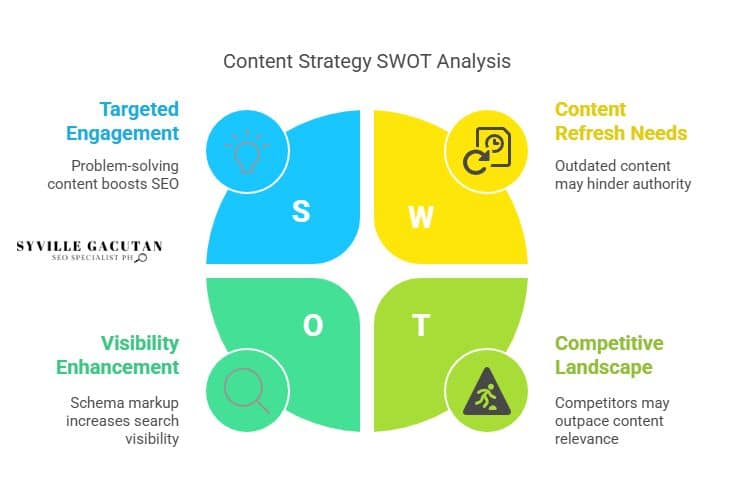
Secret SEO Tactics Every Content Marketer Should Know
Secret SEO tactics empower content marketers to boost visibility and audience engagement. Start by crafting content that solves specific problems, tapping into audience needs through effective keyword research and competitive analysis. Refresh outdated content regularly to maintain authority and relevancy. Understanding user intent is crucial; tailor content to match the diverse goals and behaviors of your audience. Implement structured data to enhance search visibility and embrace voice search optimization. Create a content ecosystem using pillar pages and strategic internal linking to enhance site authority and user experience. Engage deeply with these best SEO practices for content marketers to unlock further insights and advantages.
Key Takeaways
- Craft problem-solving content tailored to audience pain points for enhanced engagement and SEO performance.
- Refresh and revitalize outdated content using competitor analysis and multimedia to maintain relevance and authority.
- Harness user intent by mapping search behavior to tailor content that resonates with different audience goals.
- Implement schema markup and structured data to boost content visibility and achieve rich snippets in search results.
- Develop comprehensive pillar pages and strategic internal linking to create a coherent content ecosystem for better navigation and engagement.

1. Create a Problem Solver Content

One of the most effective strategies in SEO for content marketers is crafting content that directly addresses and solves specific problems faced by the target audience. In today’s competitive digital landscape, establishing authority and trust with your audience is paramount. By focusing on problem-solving content, you not only enhance user engagement but also improve your site’s search engine rankings. This approach requires a deep understanding of your target audience’s pain points and challenges.
To begin, extensive keyword research is essential. It allows you to identify the precise terms and queries your audience uses when seeking solutions. By integrating these keywords into your content, you ensure visibility and relevance. However, keyword research is only the starting point. A thorough competitive analysis is also critical to distinguish your content from rivals. Analyze the strengths and weaknesses of competitors’ content formats to uncover opportunities where your content can excel.
When creating problem-solver content, think about diverse content formats that resonate with different segments of your audience. This could range from in-depth articles and how-to guides to videos and infographics. Each format offers unique advantages in engaging your audience and addressing their needs effectively.
Lastly, strategic content distribution is vital. Even the most meticulously crafted content requires an effective distribution plan to reach its full potential. Leverage platforms where your target audience is most active, ensuring your solutions are readily accessible.
2. Harness the Power of User Intent
Understanding your audience’s needs is just the beginning; aligning your content with user intent is where true SEO success lies. To harness the power of user intent, you must first delve into the intricacies of search behavior. This involves analyzing how potential customers interact with search engines, what phrases they use, and the context in which they search.
By comprehending these patterns, you can tailor your content to meet the precise needs and expectations of your audience.
Keyword relevance is paramount in this process. It is not merely about selecting popular keywords but choosing those that reflect the specific intent of your audience. Employing intent mapping will help you identify whether users are seeking information, looking to make a purchase, or simply browsing.
This knowledge allows you to create content that is not only relevant but also compelling and authoritative.
Content personalization is another vital aspect of aligning with user intent. By segmenting your audience, you can craft highly targeted messages that resonate on a personal level.
Audience segmentation involves categorizing your audience based on various criteria such as demographics, behavior, and needs. This enables you to deliver tailored content that speaks directly to different user intents.
3. Unlock the Potential of Structured Data

Structured data is a powerful tool for enhancing the visibility and relevance of your content in search engine results. By implementing schema markup, you can transform your website’s data into a more structured format that search engines like Google can easily interpret and utilize. The structured data benefits are substantial, as it enables your content to stand out through rich snippets, thereby capturing the attention of potential customers who are ready to engage with your brand.
Harnessing schema markup is not merely a technical upgrade; it is a strategic move that can significantly enhance search visibility. This approach goes beyond traditional SEO tactics, offering a sophisticated method to communicate the essence of your content to search engines. The result is a more favorable positioning in search engine results pages (SERPs), ultimately leading to increased click-through rates and a heightened competitive edge.
In today’s data-driven world, making informed, data driven decisions is crucial. Structured data provides valuable insights into user behavior and content performance, empowering you to refine your strategies and optimize your content with precision. By understanding which elements of your content resonate most with your audience, you can tailor your approach to meet their needs and expectations more effectively.
Embracing structured data is a testament to your commitment to innovation and forward-thinking. It is a clear signal to search engines that your brand is authoritative and trustworthy. By unlocking the potential of structured data, you position your content for success, ensuring it reaches its full potential in the ever-evolving digital landscape.
4. Create a Content Ecosystem with Pillar Pages
A well-structured content ecosystem is vital for establishing authority in your niche, and pillar pages serve as the cornerstone of this strategy. By creating comprehensive pillar pages, you can organize your content hierarchy effectively and ensure that your website provides valuable insights to your audience.
Pillar pages act as authoritative hubs that connect related content through topic clustering. This method not only enhances user experience but also improves your website’s SEO performance.
To harness the true power of pillar pages, consider the following strategic elements:
- Topic Clustering: Group related topics around a central theme to create interconnected content that guides users through a logical journey. This approach maximizes engagement and keeps your audience coming back for more.
- Audience Segmentation: Tailor your pillar pages to address specific segments of your audience. By providing targeted content, you can increase relevance and conversion rates while solidifying your position as an industry leader.
- Keyword Mapping: Conduct thorough keyword research and map relevant keywords to your pillar pages. This practice ensures that your content is optimized for search engines, enhancing visibility and driving organic traffic.
SEO auditing plays a crucial role in maintaining the effectiveness of your pillar pages. Regular audits help identify any gaps or areas for improvement, ensuring that your content ecosystem remains robust and competitive.
5. Refresh and Revitalize Your Content

Building upon the structured content ecosystem established through pillar pages, another strategy to enhance your SEO and maintain audience engagement is refreshing and revitalizing your existing content. This process begins with rigorous content audits to identify areas where your material may be outdated or underperforming. By conducting these audits, you can pinpoint opportunities for keyword updates, ensuring your content remains relevant in today’s ever-evolving search landscape.
One powerful approach is to utilize competitor analysis. By understanding what resonates within your industry, you can strategically position your content to surpass others. This analysis provides insights into trending topics and successful formats, allowing you to refine your approach and capture a greater share of your audience’s attention.
Audience segmentation plays a pivotal role in revitalizing content. By tailoring your updates to specific segments, you ensure that your messaging aligns with the unique needs and preferences of each group. This targeted approach not only enhances engagement but also fortifies loyalty by demonstrating a deep understanding of your audience.
Incorporating multimedia integration can further elevate your content. By embedding videos, infographics, or podcasts, you diversify your offerings, making them more engaging and accessible. This not only boosts user experience but also increases the time visitors spend on your site, positively impacting your SEO.
Ultimately, refreshing and revitalizing your content is not just about maintaining relevance—it’s about seizing the opportunity to lead. By embracing these strategies, you assert your brand’s authority and sustain a competitive edge in the digital marketplace, ensuring continued growth and influence.
6. Optimize for the Voice Search Revolution

As voice search technology rapidly advances, it becomes crucial for content marketers to adapt their strategies to stay relevant. The voice search revolution is reshaping how users interact with digital content, and those who capitalize on this trend will maintain a competitive edge.
By integrating sophisticated voice search strategies, marketers can harness the power of voice-driven queries and enhance their digital presence.
To effectively optimize for voice search, one must prioritize natural language processing. This involves understanding how consumers articulate their queries verbally, which typically differ from typed searches. Emphasizing conversational keywords, which mirror everyday speech, can significantly improve searchability.
Furthermore, mobile optimization is indispensable, given that most voice searches occur on smartphones. Ensuring your website is mobile-friendly will cater to this growing demographic.
Local search optimization becomes paramount as voice search users often seek immediate, location-based results. Integrating local keywords and refining your business’s online listings can drive traffic and bolster visibility in local search results.
Consider these powerful tactics to stay ahead:
- Adopt Natural Language Processing: Tailor your content to understand and respond to conversational queries effectively.
- Focus on Mobile Optimization: Ensure your site is responsive and fast-loading on mobile devices to capture the voice search audience.
- Enhance Local Search Optimization: Leverage local keywords and optimize your Google My Business profile for increased local presence.
Embracing these strategies will not only align your content with technological advancements but also amplify your reach in an increasingly voice-oriented digital landscape.
7. Craft an Intricate Web of Internal Links

Why is an intricate web of internal links essential for your SEO strategy? The answer lies in the powerful synergy of internal linking strategies, which not only bolster your site’s authority but also amplify the flow of link juice, a critical component of search engine ranking.
By strategically crafting a network of internal links, you can optimize link juice distribution across your site, ensuring that each page contributes to the overall visibility and authority of your domain.
Moreover, a deliberate internal linking approach enhances user experience focus. When users navigate your content with ease, they are more likely to remain engaged, reducing bounce rates and signaling to search engines that your site is valuable.
Carefully selected anchor text relevance further strengthens this strategy, guiding users intuitively to related content that deepens their understanding and engagement with your brand.
Content navigation enhancement is another key benefit of a well-structured internal linking framework. By organizing content into a coherent and accessible structure, you facilitate seamless transitions between topics, encouraging users to explore your offerings more thoroughly.
This not only builds user trust and satisfaction but also increases the likelihood of conversions, turning casual visitors into loyal customers.
Final Thoughts
Implementing these secret SEO tactics can significantly enhance your content marketing strategy by boosting visibility and engagement. Focus on creating problem-solving content that aligns with user intent, and leverage structured data to improve search engine understanding. Building a content ecosystem with pillar pages and effective internal linking will enhance navigation and establish your authority. Regularly refreshing outdated content and optimizing for voice search will ensure your material remains relevant and accessible.
Ready to supercharge your content marketing strategy with proven SEO tactics? Connect with Syville Gacutan, a skilled SEO Specialist in the Philippines, who can help you implement these advanced strategies to boost your content’s visibility and drive measurable results. Reach out to Syville today and elevate your digital presence